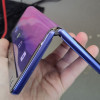Review: LG Fusic
Clock
The external screen on the Fusic displays the time in a font almost as large as the screen itself, which makes using the Fusic as a watch very simple. The screen turns itself off to save battery power, but it is easily lit up again with a short press of either volume key. Inside there are a number of clocks that can be set to fill the home screen. The default is a nearly illegible digital readout on a semi-transparent background, but all of the others are significantly easier to read.
Bluetooth
The Bluetooth menus are buried in the Tools folder. Once you find them, there is no obvious way to turn Bluetooth on and off. That is hidden in a Settings sub-menu. The Fusic supports a wide variety of desirable Bluetooth profiles including dial up networking (DUN) and stereo Bluetooth (A2DP) for listening to music on wireless headphones. Pairing the Fusic with headphones, computers and other devices was fairly straight forward, however the Fusic and our Bluetooth headphones would not always work together right away. Sometimes we needed to switch one or the other off in order for the Fusic to see our headphones and transmit music to them. Later we discovered that the Fusic will only transmit music to the headphones from the media player, not from the music store player. The Fusic supports OBEX but can only send and receive contacts (vCard,) not any other file types.
Java
Like most Sprint phones, the Fusic scores very well in JBenchmark's MIDP 1 test and less impressively in their MIDP 2 battery. The Fusic scored a 4426 in the 1.0 test, well ahead of other mid-range or even high-end feature phones. It scored a 230 in the 2.0 test, which is not nearly as impressive, but still not bad. The Fusic even fared pretty well in JBenchmark's 3D test, matching or beating many far more powerful handsets - at least those without hardware acceleration.
Other Features
The Fusic includes all the typical useful applications expected of an advanced feature phone. There is a calculator, datebook, and notepad. There is also an alarm clock with three alarms that can be set to repeat at various intervals. The alarm will not sound if the phone is turned off.
Where the Fusic goes above and beyond the call of duty is for music. There are two music players on the device. One plays music purchased through Sprint's music store or transferred to the phone (well, the memory card, really) through Sprint's software. For those who choose to use their own music collection and software, there's a second player that plays mp3s and videos saved to the memory card from any computer.
Neither application is multitasking. So if, for instance, you are walking down the street listening to your music and want to take a picture of something interesting, you will need to quit the music player to start the camera. Neither music player saves where you were in playback, making it difficult to resume after you quit. Both applications will pause to take voice calls.
Both applications work with wireless headphones or the included stereo headset. The Fusic also has an FM transmitter that lets you play your music through an FM stereo if there are no Bluetooth stereos available. Unfortunately the transmitter is very weak and doesn't work if it's more than a foot away from the antenna, which is no where near the steering wheel of most cars.
The music offerings are rounded out by a fun little music composer that lets you use your voice as a MIDI controller. You can create a tune by transcribing the music, playing it on a virtual keyboard, or even humming it.









 CTIA 2006
CTIA 2006
 LG Muziq Updates Sprint Fusic
LG Muziq Updates Sprint Fusic
 LG LX550 Launches As Fusic on Sprint
LG LX550 Launches As Fusic on Sprint
 TCL's New Foldable Concept Swings Both Ways
TCL's New Foldable Concept Swings Both Ways
 Hands On with the Motorola edge+ (2022)
Hands On with the Motorola edge+ (2022)
 LG Fusic / LX-550
LG Fusic / LX-550


